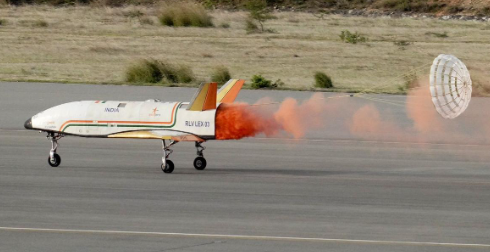Pushpak – ISRO’s Reusable Launch Vehicle, Clears Landing Test
The Indian Space Research Organization (ISRO) successfully carried out the third Reusable Launch Vehicle (RLV) Landing Experiment (LEX) on June 23 at the Aeronautical Test Range (ATR) in Chitradurga, Karnataka. This was a big step forward in space technology. As part of a larger attempt to make a fully reusable space vehicle, this project will change how people travel to space and how satellites are placed.
Context and Objective
The experiment used a winged car called “Pushpak,” which was dropped from a Chinook helicopter of the Indian Air Force from a height of 4.5 km. The vehicle then found its way to an exact landing on the centerline of the runway, even though the conditions were tougher than in previous tests. The goal of this test, called LEX-03, was to show that ISRO can still do independent landings even when conditions are more difficult, like when there is a lot of cross-range and strong winds.
Technical Highlights and Achievements
During the test, important advances in aircraft technology were shown, such as:
- Self-Navigation and Landing: Pushpak did cross-range correction maneuvers from a launching point 4.5 km away, showing improved guidance, navigation, and control systems.
- High-Speed Landing: The vehicle landed at over 320 km/h, much faster than a regular airplane. This shows how difficult it is to make space-entry vehicles that are both aerodynamically and structurally.
- Advanced Sensor Integration: The fact that inertial sensors, radar altimeters, and the NavIC could work together to make exact navigation and landing possible shows how advanced ISRO’s aerospace technology is.
- Vehicle Recovery and Reusability:After landing, the vehicle showed good braking by using its brake parachute and landing gear brakes, which is important for reusability. Notably, the winged body and flying systems from the previous LEX-02 mission were used without any changes. This shows that the launch vehicle parts are durable and can be used again.
Implications for Future Space Missions
The success of the RLV-LEX-03 is a big step toward the creation of the Reusable Launch Vehicle (RLV) technology, which will allow space missions to happen more often and for less money. The improvements in autonomous guiding algorithms and sensor fusion technology that were proven in this mission are very important for future Orbital Re-entry Missions, which need to have safe and accurate return paths.
Month: Current Affairs - June, 2024
Category: Science & Technology Current Affairs








